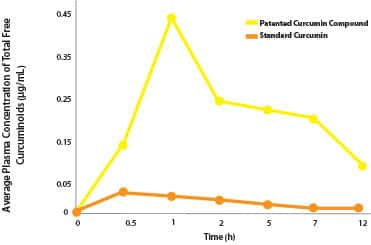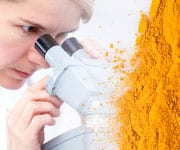Life Extension Magazine®

Dear Supporter,
Curcumin has the potential to transform medical practice.
Scientific studies reveal how curcumin functions to reduce risk for a range of age-related effects.1-6
But curcumin is poorly absorbed into the bloodstream.7
In order to garner its benefits, better forms of curcumin are needed to enhance its bioavailability.
Improvements Began in the 1990s
Over the last three decades, different curcumin compounds were developed that are better absorbed compared to the curcumin that was originally introduced in the United States.
Before reaching the blood, curcumin undergoes changes in the digestive tract that decrease the amount of active curcuminoids. This deprives cells throughout the body of optimal effects.
A giant leap forward has occurred with a new formulation of curcumin that protects against these digestive changes.
The result is an improved ability of curcumin to deliver whole-body benefits.
Difference Between Turmeric and Curcumin
Turmeric is a spice that has been used for thousands of years in South Asian cuisine.
Curcumin is the most biologically active compound in the turmeric plant.
The data about curcumin’s health benefits have motivated researchers to find better ways to deliver more active “free curcuminoids” into the blood stream.
In the 1990s, this was accomplished by adding piperine, an extract that increased curcumin absorption by mildly irritating the stomach lining.
A decade or so later, this method was improved upon by adding turmeric oil to boost curcumin absorption about seven-fold.
I am pleased to announce a new patented curcumin formulation that is better protected against changes in the intestines that limit systemic benefits. It is also far better absorbed than previous forms.
This enables more free curcuminoids to reach cells throughout the body.
Bioavailability of Free Curcuminoids
A novel form of curcumin has been shown to deliver the highest amounts of free, active curcuminoids to the bloodstream and broadest tissue penetration including the brain, liver, kidney, heart, intestine and spleen.20
A randomized, double-blind, crossover trial of 50 healthy adults reveals the superior bioavailability of this patented curcumin compound, as depicted in the graph to the right.8
Reference: J Funct Foods. 2016;22:578-87.
Clinically Studied Improvements

- 45.5- fold increased total free curcuminoids in
plasma vs. standardized turmeric powder. - More than 70% of total plasma curcuminoids are in
the active free form five hours after dosing
To assess the efficacy of this novel curcumin, several clinical trials have measured its effects on age-related factors that shorten healthy lifespans.
Some highlights from human studies using this new curcumin include:5,6,8-11
- Reduced fatigue, stress relief
- Improved quality-of-life scores
- Arterial protection
- Reduced homocysteine (30% lower)
- Increased HDL (34% higher)
- Improvement in liver enzymes (30% lower)
- Increased antioxidant enzymes (25% higher)
- Healthy inflammatory support (27% lower CRP and 15% lower IL-6)
- 45.5-fold increase in relative plasma bioavailability of free curcuminoids
What is the significance of these improvements? They represent potential reversal of several aging biomarkers.
These include reducing homocysteine, promoting arterial health, and improving inflammatory responses, along with increases in beneficial HDL cholesterol and quality-of-life scores.
These improvements correlate with published studies revealing curcumin’s potential to reduce the burden of age-related effects.
Delivering Curcumin to the Brain
Curcumin has demonstrated effects in preclinical and animal trials that have led scientists to speculate that it might help protect memory function12-18 in humans.
The challenge up until now has been to deliver adequate quantities of curcuminoids to brain cells. The intestinal environment alters curcumin’s composition in a way that reduces its bioavailability7,8 to the whole body, including to the brain.
An ongoing study is looking at brain cells’ activity before and after oral ingestion of this new curcumin compound.19
The preliminary results showed markedly higher brain cell functionality in as little as 30 minutes after ingesting 500 mg of this highly bioavailable curcumin formulation.
These findings suggest this new form of curcumin delivers real-world neurological results as demonstrated by higher EEG (electroencephalogram) brain activity.
Validating Tissue Penetration

To authenticate systemic bioavailability, an animal study measured free curcuminoids in heart, brain, kidney and other vital organs after supplementation with the new curcumin preparation.20
This type of study would be impossible to conduct in people.
The findings reveal markedly higher tissue levels of free curcuminoids throughout the animal’s body using this novel formulation, compared to regular curcumin.20
The study also showed that five hours after ingestion, more than 70% of total plasma curcuminoids were in the free, active form that can reach tissues.20
To put this into human perspective, the graph on the previous page shows a 45.5-fold increase in plasma free curcuminoids in people after ingesting this new curcumin.8
Both the human and animal data were obtained by comparing turmeric standardized to 95% curcuminoids, with this new highly bioavailable curcumin compound.
Taken together, these findings suggest this new curcumin formulation delivers systemic benefits that were previously unattainable.
Reduced Curcumin Prices
The good news for consumers is that this patented form of curcumin competes in a free market.
So, instead of costing more, the Life Extension Buyers Club has arranged for our supporters to obtain this improved curcumin formula at a price below the cost of the previous high-quality (BCM-95) curcumin.
During our annual Super Sale, the savings are even greater.
We are publishing a landmark article in early 2020 that describes the enhanced bioavailability of this novel curcumin in specific detail.
In the meantime, this new lower-priced and more highly absorbed curcumin formula is available to readers right now!
To order any item at Super Sale prices, call 1-800-544-4440 (24 hours).
For longer life,
William Faloon
Life Extension Buyers Club
References
- Bimonte S, Barbieri A, Leongito M, et al. Curcumin AntiCancer Studies in Pancreatic Cancer. Nutrients. 2016 Jul 16;8(7).
- Shakeri A, Cicero AFG, Panahi Y, et al. Curcumin: A naturally occurring autophagy modulator. J Cell Physiol. 2019 May;234(5):5643-54.
- Zendedel E, Butler AE, Atkin SL, et al. Impact of curcumin on sirtuins: A review. J Cell Biochem. 2018 Dec;119(12):10291-300.
- Shanmugam MK, Rane G, Kanchi MM, et al. The multifaceted role of curcumin in cancer prevention and treatment. Molecules. 2015 Feb 5;20(2):2728-69.
- Campbell MS, Berrones AJ, Krishnakumar IM, et al. Responsiveness to curcumin intervention is associated with reduced aortic stiffness in young, obese men with higher initial stiffness. J Funct Foods. 2017;29:154-60.
- Pandaran Sudheeran S, Jacob D, Natinga Mulakal J, et al. Safety, Tolerance, and Enhanced Efficacy of a Bioavailable Formulation of Curcumin With Fenugreek Dietary Fiber on Occupational Stress: A Randomized, Double-Blind, Placebo-Controlled Pilot Study. J Clin Psychopharmacol. 2016 Jun;36(3):236-43.
- Metzler M, Pfeiffer E, Schulz SI, et al. Curcumin uptake and metabolism. Biofactors. 2013 Jan-Feb;39(1):14-20.
- Kumar D, Jacob D, Subash PS, et al. Enhanced bioavailability and relative distribution of free (unconjugated) curcuminoids following the oral administration of a food-grade formulation with fenugreek dietary fibre: a randomised double-blind crossover study. J Funct Foods. 2016;22:578-87.
- Campbell MS, Ouyang A, I MK, et al. Influence of enhanced bioavailable curcumin on obesity-associated cardiovascular disease risk factors and arterial function: A double-blinded, randomized, controlled trial. Nutrition. 2019 Jun;62:135-9.
- Naveen TK, Thomas JV, Nair SS, et al. A novel curcumin-galactomannoside complex delivery system improves hepatic function markers in chronic alcoholics: a double-blinded, randomized, placebo-controlled study. BioMed Research International (in press). 2019.
- Saji S, Asha S, Svenia PJ, et al. Curcumin-galactomannoside complex inhibits pathogenesis in Ox-LDL-challenged human peripheral blood mononuclear cells. Inflammopharmacology. 2018 Oct;26(5):1273-82.
- Maiti P, Dunbar GL. Use of Curcumin, a Natural Polyphenol for Targeting Molecular Pathways in Treating Age-Related Neurodegenerative Diseases. Int J Mol Sci. 2018 May 31;19(6).
- Rane JS, Bhaumik P, Panda D. Curcumin Inhibits Tau Aggregation and Disintegrates Preformed Tau Filaments in vitro. J Alzheimers Dis. 2017;60(3):999-1014.
- Rao PP, Mohamed T, Teckwani K, et al. Curcumin Binding to Beta Amyloid: A Computational Study. Chem Biol Drug Des. 2015 Oct;86(4):813-20.
- Reddy PH, Manczak M, Yin X, et al. Protective effects of a natural product, curcumin, against amyloid beta induced mitochondrial and synaptic toxicities in Alzheimer’s disease. J Investig Med. 2016 Dec;64(8):1220-34.
- Reddy PH, Manczak M, Yin X, et al. Protective Effects of Indian Spice Curcumin Against Amyloid-beta in Alzheimer’s Disease. J Alzheimers Dis. 2018;61(3):843-66.
- Thapa A, Jett SD, Chi EY. Curcumin Attenuates Amyloid-beta Aggregate Toxicity and Modulates Amyloid-beta Aggregation Pathway. ACS Chem Neurosci. 2016 Jan 20;7(1):56-68.
- Yang F, Lim GP, Begum AN, et al. Curcumin inhibits formation of amyloid beta oligomers and fibrils, binds plaques, and reduces amyloid in vivo. J Biol Chem. 2005 Feb 18;280(7):5892-901.
- Unpublished Supplier Study. Data on File. 2019.
- Krishnakumar IM, Maliakel A, Gopakumar G, et al. Improved blood-brain-barrier permeability and tissue distribution following the oral administration of a food-grade formulation of curcumin with fenugreek fibre. J Funct Foods. 2015;14:215-25.

